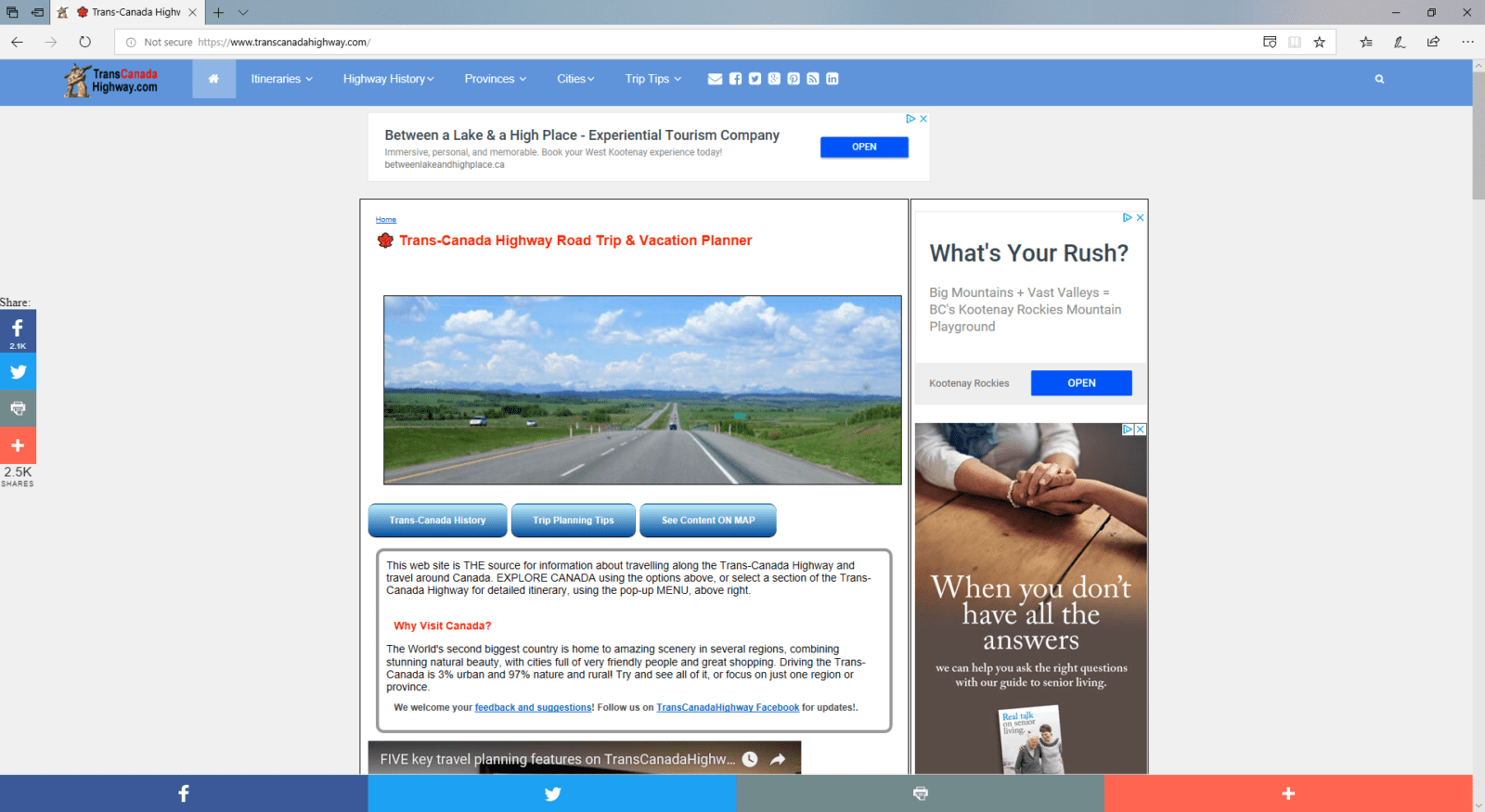Our 2023 Holiday Card from TransCanadaHighway.com and the folks at TransCanada FoundLocally Inc.

Is your web marketing up to snuff? Three Steps to Success!!
You may have a new website, you may have one many years old. Either way, you may not be achieving the results you are looking for. Old marketing methods (television, radio, newspaper, and Yellow Pages advertising) no longer get the audiences they used to, and sure don’t get the results, either. The consumer eyeballs and the future are all moving online.
Step One: Organic Content
Organic marketing is based on the content and information in your website, and how it
(a) gets search engines to spider, index, and rank your website and
(b) how it causes consumers to like you, be better informed, and make better, faster decisions. Hopefully, in your favour.
Organic content is important because it will grow your business day in and day out. If done right, it requires only a little maintenance. And if you see opportunities for improvement, make them easily and often. “Best Practices” do change over time. It’s called “organic” because you are not paying for advertising to make it do it’s thing. IT JUST IS! Organic content is always your BEST INVESTMENT.
In the olden days (a decade ago) websites were simple “brochure-ware” short brief statements of features and/or benefits, with the expectation of simply leading to a conversation with a salesman, in store, or over the phone.
Brochures were necessarily short because of
(a) the cost of printing, especially printing in colour, and
(b) constraints of how much will fit on a single sheet of paper.
BOTH those constraints no longer exist on the web… so why is it still limiting so many businesses’ communications?
Today, consumers are doing much “DUE DILIGENCE” BEFORE CALLING or shopping. They are googling for product information, and quickly checking each supplier’s websites to see which look qualified, which have the closest location, which seem the most helpful (and honest), which might have the best prices, and who’s staff have the best and most experienced people. They are also checking third-party product and business review websites for positive and negative details. THEY control the sales process & timing… YOU DON’T.
Hiding information, and still expecting a phone call or in-store visit is the kiss of death! Consumers will just choose somebody else!!
Only companies with a strong existing brand, can get away with a minimalist web site with “less information”. Companies like Apple. But they have already invested BILLIONS in creating a customer experience, and expectation of experience.
Critical Content Issues:
- Does your website cover your company/business history, describe your key products and services (with or without e-commerce), and have short bios of key staff & management?
- Is it mobile-friendly or “responsive” (works on PCs, smartphones, and tablets) in order to cover the audience regardless of device they are on or searching on, and not get [significantly] penalized by Google?
- Does it move customers through the sales process (I like to describe this as, from “hello” to “go” or from “hi” to “buy”) by educating them about choices, options, add-ons, and taxes
- Does it talk about support, returns, service after the sale? How do you build a longer term relationship with the clients?
- Does it have good contact info? Your full street/mailing address, your business hours, a Contact Us form to pre-qualify the buyers (and disqualify time-wasting “tire kickers”)
- Does it maximize the use of meta tags, TITLE tags, and keywords for pages, paragraphs, photos, links, logos, and navigation (too much can be as bad as none at all)
Check your SITE SPEED, too. Are your graphics optimized? Is your video compressed? Do you have too many JavaScript and CSS files (a common problem with WordPress sites, where every plug-in used on a site adds one of each to the process of opening and displaying every page. EEKS!). If a page takes a few seconds too load and display (more than 2-5 seconds) the site is quickly abandoned, and users go back to their Google search, and say “next!”.
Step Two: Increase Engagement
For many, this means using Social Media to expand your audience, and increase “engagement”.
As a ten year Facebook user, I consider Facebook “consumer engagement for beginners”. If consumer engagement is important (if not “mission critical”), you should not outsource that task. Let alone outsource it to someone who OWNS all the users, their contact info, and can use that against you by playing competitors’ ads anytime it damn well feels like it.
Using Social Media is a great way to expand your audience beyond those customers who already like you. Hopefully you are creating and posting content people will share on their “walls” with their “friends” and your content might even go “viral”, giving you more bang for the buck. But despite what some social media consultants tell you, this is all beyond your control or influence!
Keep in mind, that building pages and posts in Facebook, LinkedIn, Pinterest, Instagram, or Twitter builds their content, their “footprint” (more on this in a minute), and their customer engagement (if not their addictiveness) and does NOWHERE near that for yours!
If you have been posting regularly to Social Media, and you are hoping to build your audience of “followers” (or, if you are doing it in violation of Facebook’s Terms of Service your “friends” ). Keep in mind, you do not own those “followers”, Facebook does…. you cannot move or remove them from Facebook. They need to choose to connect on your site with your information feed (blog, RSS, etc). And you are investing significant time and effort to building Facebook-searchable info, and not building your website’s site, important, content, extensiveness, and completeness.
You are not building what I call website “footprint”. Like hunters in the jungle, Google ranks sites with a large footprint higher than sites with a small footprint. A site with 100,000 pages of content (like FoundLocally.com) is deemed to have more overall value than a 3,000-page website (like MovingInCanada.com), which has more value than a 5-page website for a single realtor. If your site has been static and unchanged, but your social media presence has been active, you have been DOING IT ALL WRONG!
If you are using WordPress to build & manage your website, you have the capability to post on your website pretty will every post you make in your Social Media. This means a slight change in the process, along with
(a) better training for staff to handle critical communications, and
(b) an allocation of time each day to deal with the information flow or
(c) more budget for outsourced Social Media marketers to handle it for you.
If you are NOT DOING IT, remember, your competitors surely are!
Experienced Social Media consultants also use “the 10:4:1 Rule”. Post TEN stories from outside websites for each FOUR you post pertaining to your own website and pages, articles, and products in it, to each ONE that is a hard “pitch” for business. Nobody wants to “follow”, “friend”, or subscribe to just an endless string of sales pitches. Give them some levity (puppy or kitty pictures!), industry news, information about market conditions that are both interesting and help create a better-informed consumer.
Keep in mind, that Social Media TAKES TIME. Just like in real life, you cannot earn a hundred friends in an day, so it is with online Social Media, and even when you have online “friends” it takes a while to see measurable impact from engagement efforts…. if you need faster results paid methods (on Social Media or using Google AdWords or another ad network may speed your impact.
Look at adding engagement functionality to your website to reduce your reliance on Social Media sites as your brand and customer loyalty grows. You will also be rewarded by having a bigger website footprint and therefore higher ranking on search results.
Step 3: Paid Advertising
Facebook is changing its rules for how corporate page posts are disseminated, and they are moving from a “free for business” to a “business can tease, but they must pay to reach” business model. Already, your news posts only go to 10-20% of your business Facebook followers. Even on Google, search results often put Google’s own businesses, websites, and services first (it the European Union, their courts are dining Google for such practices, but here they get away with it) , and the only way for some to get visibility is to pay for “Google AdWords” to show up at the start.
Facebook, LinkedIn, Pinterest, Instagram, and Twitter feeds have SO MANY POSTS (especially if your list of connections is in the thousands instead of the hundreds) that posts quickly disappear down the queue. This forces you to either post often or, repeat posts often. Or, pay to be displayed prominently. My Member of Parliament is “magically” appearing at the top of my LinkedIn news feed every time I login… he must be paying for the privilege.
On FoundLocally.com, TransCanadaHighway.com, and MovingInCanada.com, we accept digital advertising from two sources: Fuel Digital Media (a Montreal-based ad booking agency), and Google AdWords and DoubleClick. Google AdWords has been offering text-based keyword-focused ads for a decade. They are fast loading (only text!), relatively inexpensive, and can be well targeted. DoubleClick and Fuel Digital networks are intended for display ads (sometimes just called “banner ads”, despite the variety of shapes and sizes) and ads can incorporate graphics, images, mixed media, video, and even in-ad interactivity. Networks can offer slightly different targeting for video ads (“pre-roll” to other video content), mobile ads (no longer just small cellphone sizes, but “responsive” phone and tablet ads that resize depending on the device being used), and desktop ads.
While such ads may look great, they need to be designed & optimized for speed… a SLOW AD does not get seen, let alone clicked on. We’ve blocked some video and multimedia ads, because they slowed our site down to the annoyance of users. Also, many ads seem to have multiple cookies or 1 pixel GIF images that allow ad tracking by the advertiser, by their agency, by their ad broker, and by Google, each of these slows down page load and ad loading… the files themselves may be small, but each requires a separate http request to a different server, slowing the website down.
All ads can target the audience (“demographics’), their geography, their interests (“psychographics”), and what sites you want (or don’t want) the ad to run on. Be sure to think OUTSIDE THE BOX and don’t limit your ads to Google, Facebook, and LinkedIn. You can specifically target websites (like FoundLocally, TransCanadaHighway, and MovingInCanada) that get many users in your audience targeting, but are not big-name household brands.
When I was launching my first website, UWannaWhat (back in 1995) my advertising mentor, George Roberts, wisely counselled me to advertise on Country 105 radio. I had thought, (a) I don’t listen to country, (b) country listeners are not tech people, and (c) its not a big group or audience. My presumptions were wrong on all fronts (I soon became a Shania Twain fan, it turns out farmers use a lot of computers to plan & manage their crops, and Country radio was the top station in Calgary at the time).
Think which websites your audience LIKELY ARE USING and advertise there. It’s the best value you can find. We know radio stations, television networks, newspapers, magazines, and phone directories aren’t laying off thousands of people because they are growing… THE GROWTH IS ALL IN ONLINE.
Paid ads and cost-per-click keyword ads are really powerful when they are used to promote time-sensitive items, new website content (not yet spider, indexed, or ranked), or when you have an offer that is based on the headlines of the day. When there’s a snowstorm outside sell snowblowers, when there’s a flood sell pumps and power generators, when its Valentine’s Day sell flowers! Ads will boost your organic content and can provide a short-term boost without a long-term commitment.
It’s time to look at your best use of time & money to grow your audience and customer base. Do each of these (in order) to magnify your online presence and get higher returns and business growth. Build and improve your Organic Content, increase customer engagement using (but not limited to) Social Media, and start to consider Online Ad options.



